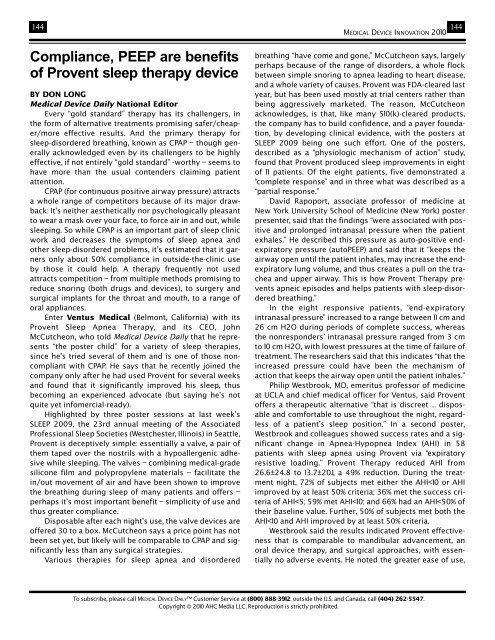MEDICAL DEVICE INNOVATION - Medical Device Daily
MEDICAL DEVICE INNOVATION - Medical Device Daily
MEDICAL DEVICE INNOVATION - Medical Device Daily
Create successful ePaper yourself
Turn your PDF publications into a flip-book with our unique Google optimized e-Paper software.
144<br />
Compliance, PEEP are benefits<br />
of Provent sleep therapy device<br />
BY DON LONG<br />
<strong>Medical</strong> <strong>Device</strong> <strong>Daily</strong> National Editor<br />
Every “gold standard” therapy has its challengers, in<br />
the form of alternative treatments promising safer/cheaper/more<br />
effective results. And the primary therapy for<br />
sleep-disordered breathing, known as CPAP – though generally<br />
acknowledged even by its challengers to be highly<br />
effective, if not entirely “gold standard” -worthy – seems to<br />
have more than the usual contenders claiming patient<br />
attention.<br />
CPAP (for continuous positive airway pressure) attracts<br />
a whole range of competitors because of its major drawback:<br />
It’s neither aesthetically nor psychologically pleasant<br />
to wear a mask over your face, to force air in and out, while<br />
sleeping. So while CPAP is an important part of sleep clinic<br />
work and decreases the symptoms of sleep apnea and<br />
other sleep-disordered problems, it’s estimated that it garners<br />
only about 50% compliance in outside-the-clinic use<br />
by those it could help. A therapy frequently not used<br />
attracts competition – from multiple methods promising to<br />
reduce snoring (both drugs and devices), to surgery and<br />
surgical implants for the throat and mouth, to a range of<br />
oral appliances.<br />
Enter Ventus <strong>Medical</strong> (Belmont, California) with its<br />
Provent Sleep Apnea Therapy, and its CEO, John<br />
McCutcheon, who told <strong>Medical</strong> <strong>Device</strong> <strong>Daily</strong> that he represents<br />
“the poster child” for a variety of sleep therapies,<br />
since he’s tried several of them and is one of those noncompliant<br />
with CPAP. He says that he recently joined the<br />
company only after he had used Provent for several weeks<br />
and found that it significantly improved his sleep, thus<br />
becoming an experienced advocate (but saying he’s not<br />
quite yet infomercial-ready).<br />
Highlighted by three poster sessions at last week’s<br />
SLEEP 2009, the 23rd annual meeting of the Associated<br />
Professional Sleep Societies (Westchester, Illinois) in Seattle,<br />
Provent is deceptively simple: essentially a valve, a pair of<br />
them taped over the nostrils with a hypoallergenic adhesive<br />
while sleeping. The valves – combining medical-grade<br />
silicone film and polypropylene materials – facilitate the<br />
in/out movement of air and have been shown to improve<br />
the breathing during sleep of many patients and offers –<br />
perhaps it’s most important benefit – simplicity of use and<br />
thus greater compliance.<br />
Disposable after each night’s use, the valve devices are<br />
offered 30 to a box. McCutcheon says a price point has not<br />
been set yet, but likely will be comparable to CPAP and significantly<br />
less than any surgical strategies.<br />
Various therapies for sleep apnea and disordered<br />
<strong>MEDICAL</strong> <strong>DEVICE</strong> <strong>INNOVATION</strong> 2010<br />
144<br />
breathing “have come and gone,” McCutcheon says, largely<br />
perhaps because of the range of disorders, a whole flock<br />
between simple snoring to apnea leading to heart disease,<br />
and a whole variety of causes. Provent was FDA-cleared last<br />
year, but has been used mostly at trial centers rather than<br />
being aggressively marketed. The reason, McCutcheon<br />
acknowledges, is that, like many 510(k)-cleared products,<br />
the company has to build confidence, and a payer foundation,<br />
by developing clinical evidence, with the posters at<br />
SLEEP 2009 being one such effort. One of the posters,<br />
described as a “physiologic mechanism of action” study,<br />
found that Provent produced sleep improvements in eight<br />
of 11 patients. Of the eight patients, five demonstrated a<br />
“complete response” and in three what was described as a<br />
“partial response.”<br />
David Rapoport, associate professor of medicine at<br />
New York University School of Medicine (New York) poster<br />
presenter, said that the findings “were associated with positive<br />
and prolonged intranasal pressure when the patient<br />
exhales.” He described this pressure as auto-positive endexpiratory<br />
pressure (autoPEEP) and said that it “keeps the<br />
airway open until the patient inhales, may increase the endexpiratory<br />
lung volume, and thus creates a pull on the trachea<br />
and upper airway. This is how Provent Therapy prevents<br />
apneic episodes and helps patients with sleep-disordered<br />
breathing.”<br />
In the eight responsive patients, “end-expiratory<br />
intranasal pressure” increased to a range between 11 cm and<br />
26 cm H2O during periods of complete success, whereas<br />
the nonresponders’ intranasal pressure ranged from 3 cm<br />
to 10 cm H2O, with lowest pressures at the time of failure of<br />
treatment. The researchers said that this indicates “that the<br />
increased pressure could have been the mechanism of<br />
action that keeps the airway open until the patient inhales.”<br />
Philip Westbrook, MD, emeritus professor of medicine<br />
at UCLA and chief medical officer for Ventus, said Provent<br />
offers a therapeutic alternative “that is discreet … disposable<br />
and comfortable to use throughout the night, regardless<br />
of a patient’s sleep position.” In a second poster,<br />
Westbrook and colleagues showed success rates and a significant<br />
change in Apnea-Hypopnea Index (AHI) in 58<br />
patients with sleep apnea using Provent via “expiratory<br />
resistive loading.” Provent Therapy reduced AHI from<br />
26.6±24.8 to 13.7±20.1, a 49% reduction. During the treatment<br />
night, 72% of subjects met either the AHI
















